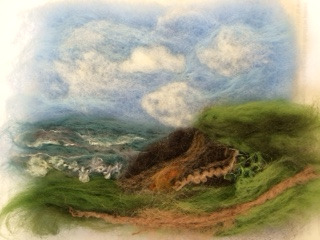Guest blog: Lilly Endowment grant fuels creativity of one ISTA member
08/05/2016
Hilda Demuth-Lutze, an ISTA member and English teacher at Chesterton High School, received a Teacher Creativity Fellowship from the Lilly Endowment. Demuth-Lutze’s grant enabled her to travel to England to study wool workers. She is now working to create felted wool landscapes of Indiana. In her guest blog, she talks about her travels and what she learned about feltmaking.
Edited by Kara Seward
Traditionally made with wool and water, felt is a resilient fabric created by the bonding of individual strands of fiber. This summer, thanks to a 2016 Lilly Teacher Creativity Fellowship, I studied the art of feltmaking in England. My husband, Mark, and I attended a wool festival, met fiber artists at galleries and studios, stayed at sheep farms and visited cathedrals in market towns built by the wool trade. We also admired England's glorious landscapes on our walks along the fells of the Lake District, the cliffs of Cornwall and the pastures of the Cotswolds.

Long after I have forgotten the locations of the many photographs we took, I will remember the kindness of the people we met — the Cumbrian couple who offered tea and biscuits when our car broke down, the Cornish hostess who invited us to a church dinner, the Staffordshire farmers who treated Mark to a livestock auction and the Herefordshire artists who opened their home and dyer's garden to us one afternoon along the River Wye.
In the felting workshops, my instructors taught more than techniques with wool and water. Among many other topics we discussed teaching, learning and the role of the arts in our lives. My Staffordshire instructor spoke of practicing ancient skills of rug making in Mongolia. My Cambridge instructor, a volunteer at a mental health facility, described the healing properties of making art.

Friendly, attentive, and relaxed, each of these teachers established an ideal learning environment by sharing her own stories and demonstrating genuine interest in my life beyond the classroom. The task at hand, making a wet-felted or needle-felted landscape, became the means to a more significant end — a mutually respectful relationship in which teacher and student learned from one another.
Back in Indiana, during these final weeks of summer break, I am blending wool from our Cotswold sheep with silk and other fibers to create a series of felted landscapes highlighting the ecological diversity of Porter County. Later this year, I will stage a formal exhibit and give presentations on feltmaking. Meanwhile, Mark is experimenting with homegrown indigo and other plant-based dyes to add more “local color” to my work.
When I return to Chesterton High School, I plan to welcome students to my classroom as warmly as Mark and I were welcomed during our travels. On my desk, a fuzzy little Cornish landscape will remind me that I am responsible not only for teaching English but also for creating an environment in which each person is both valued as an individual and bonded in the resilient fabric of our learning community.
For more information about the Lilly Endowment’s Teacher Creativity Fellowship and how to apply visit teachercreativity.org. The deadline to submit grant proposals for the 2017 grant cycle is Sept. 1.